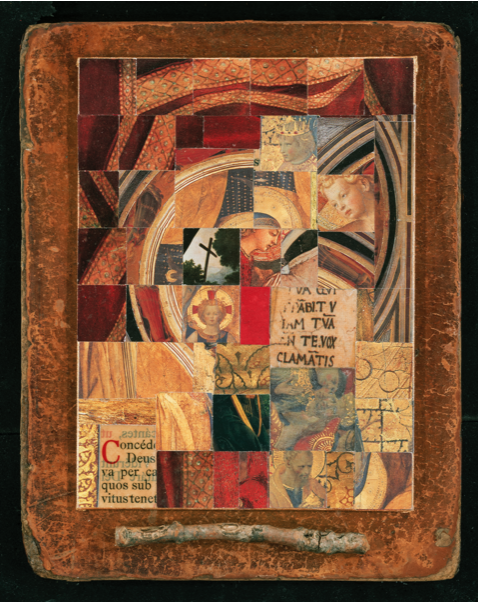This weblog began life under the banner Studio Matters for good reason. So permit me, this once, to sidestep expected topics—the baleful doings of the papal court, of an unnerving pope, and all those signals of civilizational decay. Instead, let me invite you to an exhibition at George Billis Gallery, New York City. If you are in town or passing through between January 22nd and February 23rd, perhaps you will stop by. It would be lovely if you did.
Herewith, a link to the e-catalogue, a sampling of some—not all—work on the wall. (Pages turn for browsing.)

These collages are all made from old books, book papers, bits of handwriting—artifacts gathered from the tangible history of thought. The materials serve as metaphors for the fragility of the life of the mind and of cultural memory. Champions of screen reading predict that paper books, an invention of modernity, might not be around much longer. Consider, then, a contrasting possibility: that in a digital age, books and book arts matter more than ever before.
Handwriting as well earns a threnody in digital times. Block letters will do for a generation that communicates on a keyboard. Yet for so many of us, cursive script was our first experience with disciplined drawing. It was an expressive component of literacy.
Old books in particular, redolent of time vanished, prod us to remember a world without us in it, the world our children will inherit. They tilt our attention toward the future by reminding us that the present passes, in Joseph Brodsky’s phrase, “at the speed of a turning page.”


The Dream of the Rood (8th C.) was Anglo-Saxon poet Cynewulf’s great work. It grants voice to the Cross which speaks aloud its meditation on Christ’s passion and ponders its own role in our deliverance. I was introduced to the work—to the lyricism and music of it—by Mother Angela, O.S. U., a medievalist who had a gift for summoning the lilt of Old English. To a latchkey kid from the Bronx, nothing was more magical than listening to this gaunt, intense scholar-nun reading it.
Richard Viladesau, in his cross-disciplinary study The Beauty of the Cross, introduces the poem as an example of the “inculturation” of Christianity into Germanic culture:
A triumphal vision of the cross suited the militant character and heroic ideals of the barbarian peoples converted to Christianity in the centuries after the fall of Rome. . . . Christ is portrayed as a divine hero, consciously enduring suffering for our redemption. . . . The cross itself is seen as fruitful; it is the tree of life, opposed to the tree that brought death to Adam and Eve.
“Then the young hero prepared himself,/ that was almighty God,/ Strong and firm of mood,/ he mounted the lofty cross / courageously in the sight of many, /when he willed to redeem mankind.”
To suggest the flavor of it, Viladesau pairs the Old English with modern translation. My keyboard lacks necessary alphabetic symbols and diacritical marks to do justice to the pairing. The only phrase I can copy without a single distortion is Gestah he on gealgan heanne. A literate 8th century Northumbrian would not disapprove of that rendered this way: he mounted the lofty cross.
Language, too, bears time’s signature.



